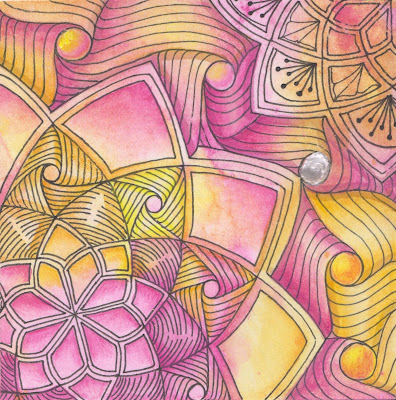For this week's Diva Challenge #289 we looked to nature and the falling Autumn leaves. The maple tree in my front yard dropped this green one a few days ago and then overnight the rest on the tree turned a brilliant gold.
I decided to use CZT Lynn Mead's technique for "zentwining" around my leaf shape. For a little while I got really attached to how it looked at this initial stage and I was wary of doing more to the tile and potentially messing it up.
But there are no mistakes in Zentangle, right? Or rather, only opportunities to honor what shows up and to "fail forward."
Kirsten's approach to teaching de-emphasized the importance of a final result and prioritized experimentation, pushing boundaries, and going too far in order to really know what "far enough" looks like. When she heard people start to worry over a piece, as I was, she repeated this light-hearted mantra: "If you're not failing, then you're doing something wrong!"
Here's what happened when I kept developing this autumn leaf-inspired tile. I think, at the very least, this stage keeps the eye more interested than the original.
Letting go of my attachment to the original drawing is a practice in itself that bears repeating. Artist Jane Davies kills her little darlings as part of creating the depth and dimension that is so integral to her signature style.
I've got one last group challenge piece for week to share with you. Here's where I started my tile for It's A String Thing adventure #167:
Again, I was ready to leave it at this stage. There's a certain elegance in simplicity, like an uncluttered room. But there wasn't much interaction between the tangles. In the spirit of failing forward I pushed it a little further.
By the way, encaustic a painting technique that uses pigments mixed with hot wax and manipulated with fire. Here's a peak at one of my creations from the workshop. Follow me on Instagram to see more!
I decided to use CZT Lynn Mead's technique for "zentwining" around my leaf shape. For a little while I got really attached to how it looked at this initial stage and I was wary of doing more to the tile and potentially messing it up.
But there are no mistakes in Zentangle, right? Or rather, only opportunities to honor what shows up and to "fail forward."
 |
| work in progress: zentwining patterned ribbons |
"To be afraid of failure is to be afraid to learn. Failure is a wonderful way to experience life, because life is a learning experience. When I fail I should rejoice, because I am closer to finding what works! Yay failing!" -- Seb BarnettThis hesitation reminded me of a conversation I had recently with artist and educator Kirsten Wilhelm when I attended a two-day studio workshop at Northwest Encaustics in Seattle. I was struggling with where to go next on one of my paintings when Kirsten advised me to "kill my little darlings" which is a reference to some age-old writing advice that advocates ruthless editing for the good over the overall work.
Kirsten's approach to teaching de-emphasized the importance of a final result and prioritized experimentation, pushing boundaries, and going too far in order to really know what "far enough" looks like. When she heard people start to worry over a piece, as I was, she repeated this light-hearted mantra: "If you're not failing, then you're doing something wrong!"
Here's what happened when I kept developing this autumn leaf-inspired tile. I think, at the very least, this stage keeps the eye more interested than the original.
 |
| Autumn Leaf with Zentwine for Diva #289 on 6" x 6" bristol paper |
"I like to build layers on the canvas or paper to build in a sort of history and the sense that there is something under the surface. Which there is. There's -- I swear there's masterpieces under there but I've just covered them all up. Yeah, I paint over a lot of stuff. I get attached to the parts that I really spent a lot of time on and worked and worked and worked. But okay, I'm attached to it and I paint over it. Now we've got a new beginning." -- Jane Davies
I've got one last group challenge piece for week to share with you. Here's where I started my tile for It's A String Thing adventure #167:
 |
| work in progress: Ponio, Winflo for IAST #167 |
Almost certainly the Winflo and Ponio designs could still have more interaction, but for now this is where I leave it.
 |
| Ponio and Winflo for IAST 167 on traditional Zentangle tile |



